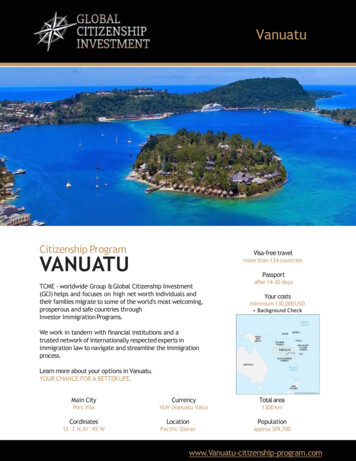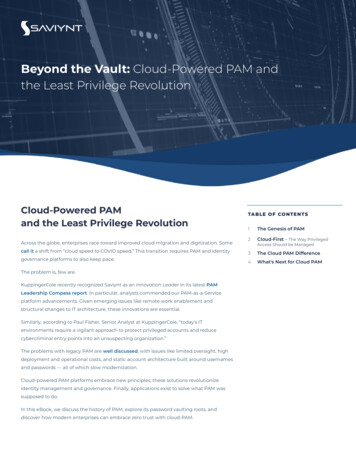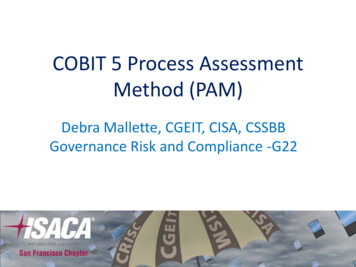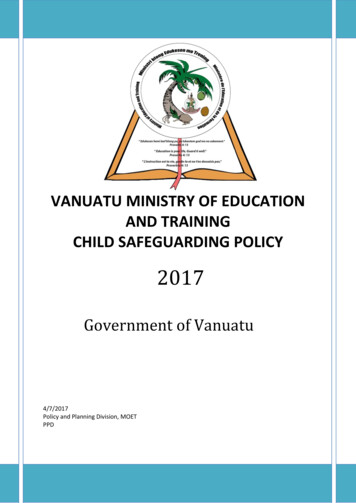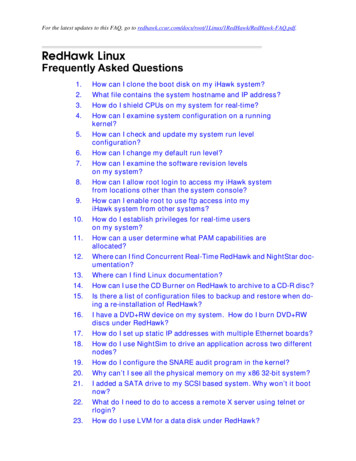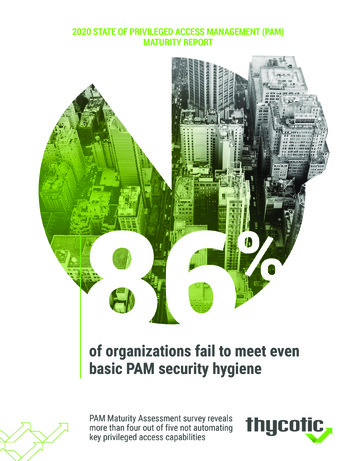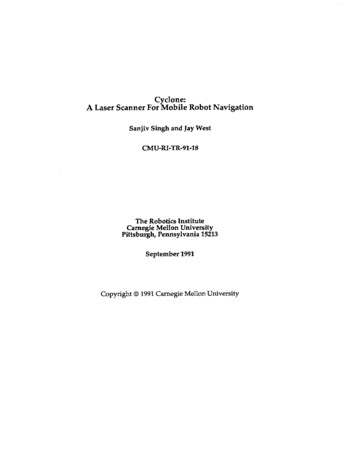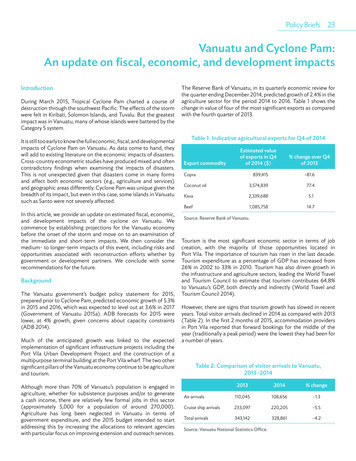
Transcription
Policy Briefs 23Vanuatu and Cyclone Pam:An update on fiscal, economic, and development impactsIntroductionDuring March 2015, Tropical Cyclone Pam charted a course ofdestruction through the southwest Pacific. The effects of the stormwere felt in Kiribati, Solomon Islands, and Tuvalu. But the greatestimpact was in Vanuatu, many of whose islands were battered by theCategory 5 system.It is still too early to know the full economic, fiscal, and developmentalimpacts of Cyclone Pam on Vanuatu. As data come to hand, theywill add to existing literature on the economic impacts of disasters.Cross-country econometric studies have produced mixed and oftencontradictory findings when examining the impacts of disasters.This is not unexpected given that disasters come in many formsand affect both economic sectors (e.g., agriculture and services)and geographic areas differently. Cyclone Pam was unique given thebreadth of its impact, but even in this case, some islands in Vanuatusuch as Santo were not severely affected.In this article, we provide an update on estimated fiscal, economic,and development impacts of the cyclone on Vanuatu. Wecommence by establishing projections for the Vanuatu economybefore the onset of the storm and move on to an examination ofthe immediate and short-term impacts. We then consider themedium- to longer-term impacts of this event, including risks andopportunities associated with reconstruction efforts whether bygovernment or development partners. We conclude with somerecommendations for the future.BackgroundThe Vanuatu government’s budget policy statement for 2015,prepared prior to Cyclone Pam, predicted economic growth of 5.3%in 2015 and 2016, which was expected to level out at 3.6% in 2017(Government of Vanuatu 2015a). ADB forecasts for 2015 werelower, at 4% growth, given concerns about capacity constraints(ADB 2014).Much of the anticipated growth was linked to the expectedimplementation of significant infrastructure projects including thePort Vila Urban Development Project and the construction of amultipurpose terminal building at the Port Vila wharf. The two othersignificant pillars of the Vanuatu economy continue to be agricultureand tourism.Although more than 70% of Vanuatu’s population is engaged inagriculture, whether for subsistence purposes and/or to generatea cash income, there are relatively few formal jobs in this sector(approximately 5,000 for a population of around 270,000).Agriculture has long been neglected in Vanuatu in terms ofgovernment expenditure, and the 2015 budget intended to startaddressing this by increasing the allocations to relevant agencieswith particular focus on improving extension and outreach services.The Reserve Bank of Vanuatu, in its quarterly economic review forthe quarter ending December 2014, predicted growth of 2.4% in theagriculture sector for the period 2014 to 2016. Table 1 shows thechange in value of four of the most significant exports as comparedwith the fourth quarter of 2013.Table 1: Indicative agricultural exports for Q4 of 2014Export commodityEstimated valueof exports in Q4of 2014 ( )Copra% change over Q4of 2013839,415–81.6Coconut ource: Reserve Bank of Vanuatu.Tourism is the most significant economic sector in terms of jobcreation, with the majority of those opportunities located inPort Vila. The importance of tourism has risen in the last decade.Tourism expenditure as a percentage of GDP has increased from26% in 2002 to 33% in 2010. Tourism has also driven growth inthe infrastructure and agriculture sectors, leading the World Traveland Tourism Council to estimate that tourism contributes 64.8%to Vanuatu’s GDP, both directly and indirectly (World Travel andTourism Council 2014).However, there are signs that tourism growth has slowed in recentyears. Total visitor arrivals declined in 2014 as compared with 2013(Table 2). In the first 2 months of 2015, accommodation providersin Port Vila reported that forward bookings for the middle of theyear (traditionally a peak period) were the lowest they had been fora number of years.Table 2: Comparison of visitor arrivals to Vanuatu,2013–201420132014% changeAir arrivals110,045108,656–1.3Cruise ship arrivals233,097220,205–5.5Total arrivals343,142328,861–4.2Source: Vanuatu National Statistics Office.
24 Pacific Economic MonitorVanuatu and Cyclone Pam: An updateImmediate and short-term impactsTropical Cyclone Pam is the largest cyclone ever to have hitVanuatu and is one of the most severe storms experienced inthe Pacific. It directly affected 22 of the 63 inhabited islands,destroying and damaging housing, crops, businesses, and criticalpublic infrastructure including schools, medical facilities, roads, andbridges. The official death toll of 11 is astonishingly low given thestrength of the cyclone and its widespread impact. This is a creditto both the disaster preparedness of the Vanuatu government andthe resilience of Ni-Vanuatu, who have long been accustomed tocyclonic activity.The most immediate need in the aftermath of Cyclone Pam wasfor a humanitarian response to address needs for water, shelter,and food. The government of Vanuatu and the UN Office for theCoordination of Humanitarian Affairs launched a flash appeal toraise funds to provide humanitarian assistance for a 3-month perioduntil the end of June. Subsequently, a humanitarian action plan torun until the end of July was prepared and the combined requestedfunding is 38 million.Given the importance of subsistence agriculture to the population ofVanuatu, food security has been a matter of great importance in theimmediate and short term. The government has led the distributionof food aid, largely in the form of rice, tinned fish, noodles, andhigh-energy biscuits, with the assistance of humanitarian partnersincluding the World Food Program. With each issue of food aid, ruralcommunities have received seeds, seedlings, and gardening toolsso that food gardens could be reestablished as soon as possible.On 1 June the government launched the Urban Gardens project topromote the use of state land and undeveloped leased land as foodgardens for a 12-month period in recognition of the need to addressurban food security issues (Newton Cain 2015).It became very clear very quickly that the logistical implicationsand associated costs associated with meeting the humanitarianneeds are many and varied. In the very early stages of the response,these difficulties were exacerbated by a lack of communications,particularly with rural and remote areas. There was no shortageof offers of help from near and far, from governments, NGOs,the private sector, and others. From the start, the government ofVanuatu made it clear that it intended to lead the response (andsubsequent activities related to recovery), and this caused sometension between the government and NGOs. A number of seniorofficials were seconded to work within and with the National DisasterManagement Office on aid distribution, placing additional strain ona small bureaucracy with limited across-the-board capacity.In the immediate aftermath and as a way of promoting early recoveryefforts, the government made a number of decisions with fiscal andeconomic implications.(ii)release of 9,124 to each of the country’s 52 members ofParliament (i.e., a doubling of the constituency allowance for2015); and(iii) direction to the Vanuatu National Provident Fund (thenational pension fund) to facilitate members to withdraw20% of their retirement accounts to fund rebuilding and/orlivelihood restoration.These measures supported households in the aftermath of thecyclone. However, they also adversely affected the fiscal positionof the government, which is under considerable pressure (and islikely to remain so for some time) given the expected downturnin two of the most significant sectors, agriculture and tourism, as aconsequence of the cyclone. During the recent extraordinary sittingof Parliament, a supplementary budget of 437,956 was approved.Government estimates of economic growth in Vanuatu havebeen modified considerably to take into account the effects ofCyclone Pam. Figure 1 shows economic growth estimates both priorto and after the passage of Cyclone Pam. In its postdisaster needsassessment, the Government of Vanuatu estimates that CyclonePam had a substantial negative impact on GDP, but the impactwill be mitigated to some extent by economic activity associatedwith recovery and reconstruction. Growth in 2015 is now projectedat 1.4% (Government of Vanuatu 2015b). This is 3.2% lower thanexpectations prior to Cyclone Pam, but higher than initial forecastsin the immediate aftermath of the cyclone (a preliminary assessmentby ADB projected a contraction of –0.5%, and the recent IMFArticle IV Consultation projects growth of –2.0%).Figure 1: Impact of Cyclone Pam on projected GDP growthin Vanuatu% p.a.1210864202005 060708PrecycloneThey were:(i)waiver of VAT and duty on imported seeds, gardening tools,and building materials;09101112131415p 16p 17pPostdisaster needs assessmentGDP gross domestic product, p projection.Source: Dornan, M. 2015. Vanuatu after Cyclone Pam: the economic impact.Devpolicy Blog. economic-impact-20150410
Policy Briefs 25Vanuatu and Cyclone Pam: An updateEconomic activity is expected to rebound in 2016 due toreconstruction and recovery activity, as well as the commencementof a number of large infrastructure projects conceived prior toCyclone Pam. The government’s postdisaster needs assessmentpredicts GDP growth of 10.3% in 2016. It should be noted thatthis estimate is affected by the availability of finance and capacityconstraints and is therefore subject to a high degree of uncertainty.ADB estimates made in the initial aftermath of Cyclone Pampredicted significantly lower growth of 4%. The recent IMF Article IVConsultation projects growth of 5% in 2016.Future growth rates will depend on how quickly tourism recovers.This sector is of particular concern, given its overwhelmingimportance to the economy as a whole. While cruise ship callsresumed in a short space of time, a number of properties in andaround Port Vila had to close for repairs and both Air Vanuatu andVirgin Australia reduced their flight schedules, reflecting a dropin demand. Many properties have now reopened, but two of thebiggest will be closed until the end of 2015.Experience in other countries suggests that there is reputationaldamage associated with large-scale disasters such as Cyclone Pam,and that it can take years for the tourism sector to fully recoverfrom such events. This stresses the importance of a new campaignpromoting Vanuatu as a holiday destination in the largest sourcemarkets (Australia, New Zealand, and New Caledonia). Vanuatu’smost significant competitor in the tourism market, Fiji, is likely tobenefit from the expected downturn in Vanuatu in the meantime(Figure 2 shows the substitution effect between these twodestinations).Medium- to longer-term outlookAs Vanuatu moves from the humanitarian response stage torecovery and reconstruction, the enormity of the task has becomeapparent. Again, experience from elsewhere may give someindication about how this event could affect economic activity andgrowth in Vanuatu. Loayza et al. (2009) determined that a “typical”(median) disaster has a negative impact on medium-term futureeconomic growth, although the effects vary according to the typeof disaster experienced and the sector under consideration. In somecases, disasters are found to have positive economic impacts, suchas where the industrial sector increases output further after floods,earthquakes, and storms (including cyclones)—no doubt as a resultof subsequent reconstruction activities. However, this should not beequated with economic welfare or well-being.In Vanuatu, household spending on rebuilding and rehabilitationis already making it difficult for families to maintain or increaseinvestment in nonrecovery activities such as education (Dornan andNewton Cain 2015a). The economic literature suggests that severedisasters such as Cyclone Pam have effects that are considerablymore pronounced than ‘median’ disasters. In these cases, there is aclear negative impact on future GDP and future output in agricultural,industrial, and service sectors. The extent of these impacts dependson a range of factors. Cavallo and Noy (2010) found after reviewingthe literature that the medium- to longer-term economic impactsFigure 2: Comparison of visitor arrivals to Fiji and Vanuatu800120600904006020030002006070809Fiji (’000, lhs)1011121314Vanuatu (’000, rhs)lhs left-hand scale, rhs right-hand scale.Source: ADB. 2014. Pacific Economic Monitor database. www.adb.org/pacmonitorare affected by a country’s “ability to mobilize significant funding forreconstruction.” They argue that, as a result, poor countries suffermore in the medium and longer term owing to disasters.The Vanuatu government’s postdisaster needs assessment,prepared with support from development partners, notes that theeconomic value of the impacts of Cyclone Pam amounts to 449.4million (Government of Vanuatu 2015b). This equates to 64.1%of GDP (based on the 2013 figures). By comparison, the costs ofreconstruction in Samoa after Cyclone Evan in 2012 equated to30% of GDP. The assessment report cautions that the estimatesof damage and loss are likely to be underestimates as a result oflimitations to the data that were available at the time. Table 3provides more detail as to damage and loss in selected sectorsof the Vanuatu economy, as reported in the postdisaster needsassessment.In terms of estimated recovery costs, the postdisaster needsassessment is equally sobering. The total estimated cost of recoveryover a 4-year period is 328.2 million (43.3% of GDP), with 52% ofthis relating to the public sector.These costs are far beyond the government’s ability to meetfrom domestic revenue even without the extra pressures on thecurrent account referred to earlier. The need for external fundingis undeniable. The previous Council of Ministers was consideringa 2-year reconstruction and recovery plan that will set out thepriorities for reconstruction and rehabilitation of public assetssuch as schools and health facilities. We have yet to see how thiswill progress given the change of government on 12 June. There hasalready been recognition that there will need to be prioritizationof which assets are to be replaced and/or repaired. Managingcommunity and political expectations is likely to prove tricky, notleast because the country will go to general elections in 2016.
26 Pacific Economic MonitorVanuatu and Cyclone Pam: An updateTable 3: Estimates of economic value of impact on selected sectors of the Vanuatu economyDisaster effects ( million)DamageShare of disaster effects (%)LossesTotalPrivatePublicProductive .75.8138.667.033.0Housing 0.0100.0Infrastructure 9.469.031.0Commerce and industryTourismSocial sectorsTOTALNotes: Damage (or direct impacts) refers to the economic and financial impacts resulting from damaged infrastructure and physical assets. Losses (or indirectimpacts) refers to economic and financial impacts resulting from changes in economic activities, such as reduced tourism numbers or higher prices for certaininputs to production. Exchange rate used is 1 108.04 vatu.Source: Government of Vanuatu. 2015c. Budget Policy Statement 2016. Port Vila.There are a number of ways that this work will be financed. Whilea surge in aid will cover some of the reconstruction costs, previousexperience from around the world indicates that it will fall well shortof what is required (Becerra, Cavallo, and Noy 2012). Closer tohome, past disasters in Vanuatu (three cyclones during 1985) andSamoa (Cyclone Evan in 2012) generated an increase in aid thatamounted to around 5% of GDP, well short of what was required(Dornan and Newton Cain 2015a).Development partners, in providing support, should be striving toharmonize their processes and absorb more of the transaction costsinvolved in getting projects approved. The Vanuatu governmenthas become increasingly vocal about the need for donors to usegovernment systems since Cyclone Pam. With an inflow of large sumsof aid, there is a real risk that parallel systems will be created, and thatthe best and brightest Ni-Vanuatu will seek employment with donoragencies and/or NGOs at the expense of government institutions.Use of government systems is low in Vanuatu, partly due to donorperceptions of poor governance, and partly due to limited capacityin line areas of government that could otherwise implement donorfunded projects. In 2010, less than 30% of aid provided to Vanuatuwas directed through government mechanisms (Vanuatu PeerReview Team 2010). It is in this context that the previous primeminister has specifically requested budget support, and has askedthat development partners make greater use of government systemsand processes.The Vanuatu government will also need to borrow funds forreconstruction, as did the Government of Samoa after Cyclone Evan.Access to finance for reconstruction is an essential element ofrecovery, and one that influences the severity of the economicimpacts of a disaster (Cavallo and Noy 2010). Vanuatu is currently in asound fiscal position, with public debt equivalent to only 21% of GDP,well below the 40% threshold recommended by the InternationalMonetary Fund. On the face of it, the Vanuatu government is ina position to borrow money for reconstruction. However, closerinspection reveals a somewhat different story. It currently has asignificant pipeline of infrastructure investments forecast, which is tobe funded through a combination of grants and concessional loansfrom donors. These projects would result in a considerable increasein public debt (Figure 3).It would be preferable to cancel or postpone some of these projectsin order to provide greater flexibility for borrowing to financereconstruction. However, the political realities are likely to make thatvery difficult (Dornan and Newton Cain 2015a). Debt managementis therefore going to be a crucial element in Vanuatu’s longerterm recovery, with careful attention required to what projects areapproved and on what terms. This will also need to be an importantconcern among development partners.Conclusions and recommendationsVanuatu faces significant challenges as it seeks to rebuild andrecover from Cyclone Pam. The recovery of the tourism sector willbe a crucial determinant of Vanuatu’s medium-term economicprospects. A proactive strategy to rebuild the sector is needed,including promotional activities that have in the past receivedlimited government attention and funding. As part of “building back
Policy Briefs 27Vanuatu and Cyclone Pam: An updateFigure 3: Vanuatu government debt45,0004030Lead authors: Matthew Dornan, Development Policy Centre,Australian National University, and Tess Newton Cain,Visiting Fellow to the Development Policy Centre(based in Vanuatu).30,00020References:ADB. 2014. Pacific Economic Monitor database. December.15,0001000201220132014eExternal debt (vatu million, lhs)Domestic debt (vatu million, lhs)2015b2016p2017pBecerra, O., E. Cavallo, and I. Noy. 2012. Foreign Aid in theAftermath of Natural Disasters. IDB Working Paper Series. 333.Inter-American Development Bank.2018pTotal government debt(% of GDP, rhs)lhs left-hand scale, rhs right-hand scale.Source: Dornan and Newton Cain. 2015a. Vanuatu after Cyclone Pam: how willreconstruction be financed? Devpolicy Blog. � efforts will need to extend beyond Port Vila to ensure that allcommunities affected by the cyclone benefit (Dornan and NewtonCain 2015b). The reconstruction of infrastructure linking thesecommunities to Port Vila should be a priority for the same reason.Access to finance and the way in which capacity constraintsare managed will also be important. Both have the potentialto undermine reconstruction and recovery activities—a pointemphasized in the economic literature on disasters. Damage fromCyclone Pam, estimated at the equivalent of 64.1% of GDP, meansthat very significant funding is required for reconstruction. Thegovernment will be expected to finance over half of this amount,both for repair of government infrastructure and services and insupport of private sector recovery efforts.Development partners can be expected to, and are already, assistingwith this effort. However, development assistance is unlikely to fundmore than a modest proportion of the total expenditure required.This highlights the importance of ensuring that assistance is welltargeted, with partners coordinating their assistance and workingclosely with the Vanuatu government—measures also important formanagement of capacity constraints.The Government of Vanuatu will also need to borrow to fund thereconstruction and recovery effort. It is currently in a position todo so; however, a pipeline of new infrastructure partially fundedthrough concessional loans means that care will need to be takento avoid excessive borrowing. The terms of new debt will need to bescrutinized closely to ensure that the quality of future loans is givendue consideration. Prioritization of infrastructure projects will alsobe required. There is no doubt that this will be politically challenging.The resilience shown by Ni-Vanuatu in recent months, togetherwith a commendable response by the Vanuatu government, shouldnevertheless be cause for optimism.Cavallo, E. and I. Noy. 2010. The Economics ofNatural Disasters: A Survey. IDB Working Paper Series. 124.Inter-American Development Bank.Dornan, M. 2015a. Vanuatu after Cyclone Pam: the economicimpact. Devpolicy Blog. economic-impact-20150410Dornan, M. and T. Newton Cain. 2015a. Vanuatu afterCyclone Pam: how will reconstruction be financed? DevpolicyBlog. will-reconstruction-be-financed-20150507Dornan, M. and T. Newton Cain. 2015b. ‘Tourism andeconomic diversification in Vanuatu’ fication-in-vanuatu-20150616Government of Vanuatu. 2015a. Budget 2015. Volume 1.Port Vila.Government of Vanuatu. 2015b. Draft Post-Disaster NeedsAssessment—Tropical Cyclone Pam. March.Government of Vanuatu. 2015c. Budget Policy Statement 2016.Port Vila.Loayza, N. et al. 2009. Natural Disasters and Growth—Going Beyond the Averages. Washington, DC: World Bank.Newton Cain, T. 2015. Food security responses in Vanuatushould include urban gardens. ardensReserve Bank of Vanuatu. 2015. Quarterly Economic Review.December 2014. 115(4).Vanuatu Peer Review Team. 2010. Vanuatu Peer Review Report.Pacific Islands Forum Secretariat.World Travel and Tourism Council. 2014. Travel and TourismEconomic Impact 2014: Vanuatu. London.
importance to the economy as a whole. While cruise ship calls resumed in a short space of time, a number of properties in and around Port Vila had to close for repairs and both Air Vanuatu and Virgin Australia reduced their fl ight schedules, refl ecting a drop in demand. Many properties have now reopened, but two of the
